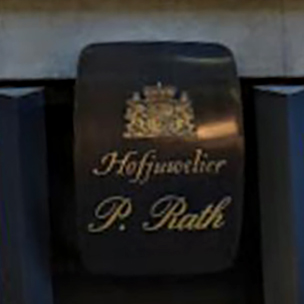Rothmüller

Rothmüller (founded 1886)
Rothmüller, Karl Senior (1860 –1930)
Rothmüller, Karl (1894 – 1972)
Rothmüller, Hanns (1898 – 1983)
The house of Rothmüller assumes an important position among Munich jewellers. The goldsmith works from the Prinzregentenzeit (Regent Luitpold of Bavaria 1886 – 1912) until the 1920s are influenced by Munich Jugendstil, after which their decorative elements orient more toward the French Art Déco.
The professor of fine arts Karl Rothmüller is considered among the most important German goldsmiths of his time. He learns under Fritz von Miller, studies at the Schools for Arts and Crafts in Munich and Vienna and works in Berlin, Paris and London before opening his own workshop in Munich in 1886. Beginning in 1897 he participates consistently in exhibitions at the Munich Glass Palace. In 1900 he exhibits at the World Expo in Paris. In 1908 he is honoured with the title of Royal Goldsmith to the Bavarian Court and opens three jewellery stores in Munich. In 1910 and 1919 his sons Karl and Hanns join him in the workshop. Until the outbreak of the First World War, he is considered the epitome of a modern German jewellery artist. During the war years, he fashions foliate forms and stylized plants from black opals, baroque pearls, olivines, rubies and amethysts. After 1918, the successful Munich goldsmith and guild member (Werkbund) is able to take advantage of his previous success, but offers nothing new. In 1920, the long-time chairman of the Bavarian Kunstgewerbeverein (guild for arts and crafts artists) assists in the establishment of the Danner Foundation. The workshop first begins to produce Art Déco designs in 1925. The generally reserved use of colour has now been replaced by bold colours and centrally placed gemstones.
Rothmüller, gegründet 1886
Rothmüller, Karl Senior 1860 -1930
Rothmüller Karl 1894 – 1972
Rothmüller Hanns 1898 – 1983
Eine bedeutende Stellung unter den Münchner Juwelieren nimmt das Haus Rothmüller ein. Beeinflusst sind die Goldschmiedearbeiten der Prinzregentenzeit noch bis in die 1920er Jahre vom Münchner Jugendstil, bevor sich ihr Schmuckdekor am französischen Art Déco orientiert.
Der Professor der bildenden Künste Karl Rothmüller gehört zu den bedeutendsten deutschen Goldschmieden seiner Zeit. Er lernt bei Fritz von Miller, studiert an den Kunstgewerbeschulen in München und Wien und arbeitet in Berlin, Paris und London bevor er 1886 seine eigene Werkstatt in München eröffnet. Seit 1897 nimmt er an den Ausstellungen im Münchner Glaspalast teil. 1900 stellt er auf der Pariser Weltaustellung aus. 1908 erhält er den Titel Königlich Bayerischer Hofgoldschmied und eröffnet drei Juweliergeschäfte in München. 1910 und 1919 treten seine Söhne Karl und Hanns in die Werkstatt ein. Bis zum Ausbruch des Ersten Weltkriegs gilt er als Inbegriff eines modernen deutschen Schmuckkünstlers. Durch die Kriegsjahre hindurch fertigt er mit schwarzen Opalen, Barockperlen, Olivinen, Rubinen und Amethysten besetzte Blattgespinste oder stilisierte Pflänzchen. Nach 1918 kann der erfolgreiche Münchner Goldschmied und Werkbundmitglied an seinen alten Erfolg anknüpfen, bietet aber nicht wirklich Neues. 1920 hilft der langjährige Vorstand des Bayerischen Kunstgewerbe-Vereins bei der Gründung der Danner-Stiftung. Erst ab 1925 setzt sich in der Werkstatt der französische Art Déco Stil durch. Die dezenten Farbgebungen werden nun durch farbkräftige, meist zentral verwendete Edelsteine ersetzt.